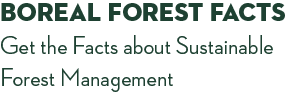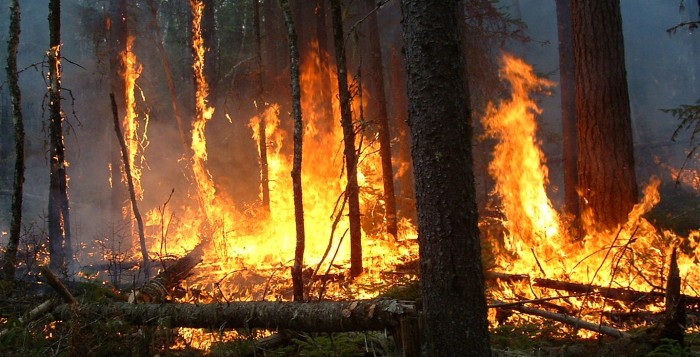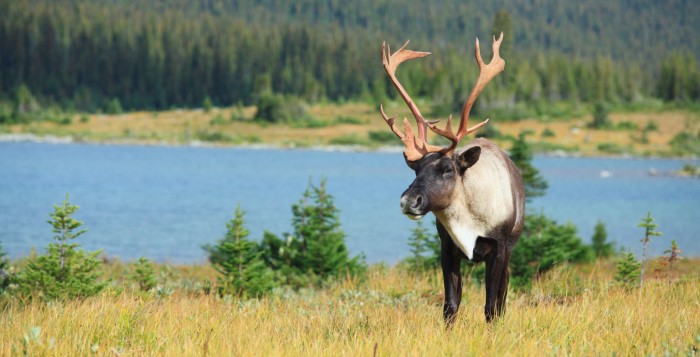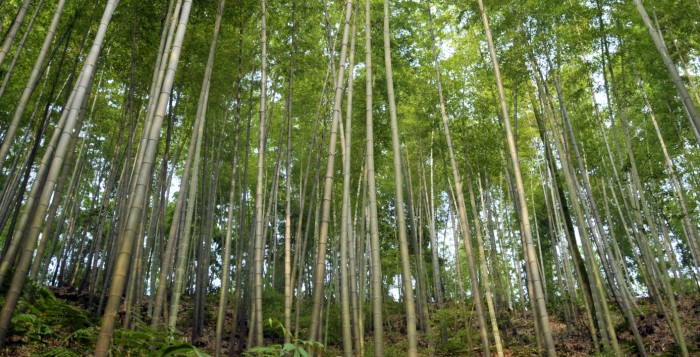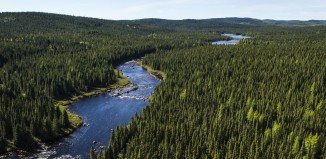While certainly a threat to public safety and property, forest fires have an important role to play in the life of a forest. Here are five answers to the big questions surrounding wildland fires:
- How do fires start?
Lightning is often the cause of wildland fires in more remote regions during the summer when dry conditions can persist. But Natural Resources Canada (NRCan) estimates that more than half of a season’s fires can be attributed to human causes like a spark from machinery to carelessness in the form of unattended campfires, discarded cigarettes and uncontrolled yard waste burns.[2] But for Canada’s boreal forest, the main ignitor is lightning.
See a live map of current lightning activity in Canada.
- How do they spread so quickly?
Beyond a source of ignition, wildland fires also need dry fuel and hot, dry, windy weather. And to continue to burn, they need heat, oxygen, and fuel (this is known as the fire triangle). Once ignited, fires can move quickly – up to 23 kph by some estimates.[3] And depending on the amount and type of fuel available, the weather and the topography, a fire can continue to spread. The heat from the existing burn causes the moisture in the adjacent fuel to evaporate so that it becomes easier to ignite. Wind provides the flames with oxygen and pushes the fire across a landscape at a faster rate. A large fire will also create a wind of its own, sometimes as much as 10 times faster than the ambient wind, which will propel embers high into the air to start fires in other areas.[4]
- Are all fires as dramatic as the images we see in the news?
No. There are essentially three different types of fires. The ones you see most often in images and news reports are called crown fires because they burn up to the top of a tree. These ones are considered most dangerous. Surface fires burn fuel elements like dried leaves, branches and pine needles on the forest floor. They tend to be easier to control and put out. The last one, the ground fire, is a subsurface fire that can even occur underground where there are deep accumulations of dead vegetation that have become dry enough to burn. These ones tend to smoulder for long periods.
Watch a high-intensity crown fire from the ground as it moves through an area.
- What is the role of fire in forest ecology?
In a word, it’s about diversity. And particularly for the boreal, which is composed of everything from pure deciduous to mixed deciduous-coniferous to pure coniferous. Decay doesn’t occur as quickly under the boreal’s cool temperate conditions as it might in warmer, more humid climates so fire is a natural way to convert the branches, logs and leaves on the ground to a mineral-rich ash. This releases and recycles nutrients.
The gaps in the forest created by fire also allow sun to penetrate and stimulate the growth of pioneer species like aspen, white birch, jack pine and lodgepole pine. If fire does not occur in this same forest over the next 100 years, black spruce will flourish in the shade these pioneer species provide.
And as birds carry seeds to new areas, a patchwork of vegetation develops, populated by different species at various levels of maturity. By rearranging vegetation, fires support the formation of diverse ecosystems that are home to a variety of populations of insects, mammals and birds.
- When is a fire simply allowed to burn?
It generally comes down to whether the fire poses a risk to human life and property. For most of the 20th century, forest fires were seen as a destructive force that needed to be suppressed. And we were generally successful. But we’ve since come to understand that fire, like wind and water, is just another element of the ecosystem. Today’s forest fire strategies range from putting out a fire to actually setting fires on purpose (these are known as prescribed burns and are used to eliminate potential fuel sources).
Learn more about how Ontario air crews set prescribed fires.
Agencies responsible for fire suppression in an area have a number of tools available to them to assess the risk to humans and property. As NRCan explains, high-priority areas for protection include residential areas, high-value commercial forests and recreational sites. Low-priority sites are generally wilderness parks and remote forests of limited economic value—although protection of rare habitat, culturally significant areas and similar values will influence suppression decisions.[5]
[1] http://www.cbc.ca/news/canada/thunder-bay/forest-fire-season-quiet-in-ontario-compared-to-average-1.3227997
[2] http://www.nrcan.gc.ca/forests/fire-insects-disturbances/fire/13145
[3] http://science.howstuffworks.com/nature/natural-disasters/wildfire.htm
[4] http://science.howstuffworks.com/nature/natural-disasters/wildfire2.htm
[5] http://www.nrcan.gc.ca/forests/fire-insects-disturbances/fire/13157
Herbicides are an important tool for regenerating harvested forest areas. Glyphosate is the most commonly used herbicide in Canada, but misconceptions abound. Here, we answer some common questions about glyphosate.
Why do we use glyphosate?
In Canada, 100% of harvested areas must be reforested. Most harvested areas in Ontario and Quebec grow back naturally. Foresters ensure the rest is promptly regenerated – often through non-chemical methods, and where necessary, with the help of herbicides like glyphosate.
As much as possible, foresters aim to regenerate harvested areas with the same species that were present before the harvest. But at the early stage of the regeneration process, certain plant species, known as “pioneer” species, threaten to overtake the young spruce and pine saplings and hinder their growth in certain areas. Glyphosate is highly effective at controlling these competing species in order to reinstate the proper species cover.
No matter the method of regeneration in a given area, the process is closely monitored and highly regulated to ensure its success[1].
If some areas regenerate without herbicides, are they really necessary?
In areas that need help regenerating, the objective is to regenerate to a specific standard. Different areas see varying amounts of success depending on the method of control used. Mechanical control is often used for shrub vegetation, but is mostly ineffective against herbaceous competition. Many other methods have been tried, including laying down mulch mats, bringing in grazing livestock and even developing an indigenous fungus as a microbial biocontrol agent. But the fact is, no other method is as cost-effective, efficient or reliable as modern chemical herbicides[2].
And if competing vegetation is not controlled, some areas see reduced or even failed regeneration.
Is glyphosate safe?
Glyphosate has been mentioned in the news in recent months, and many people are understandably concerned about its effects. However, scientists and regulators maintain that glyphosate poses minimal risk to people and to our environment.
According to the Canadian Forestry Service:
“The potential effects of a herbicide on either humans or any wildlife species depends on the magnitude, duration, frequency and route of exposure. Just as there are levels of alcohol or caffeine that may be consumed without any noticeable or measurable effect, there are levels of exposure for wildlife or humans to herbicides for which we cannot observe or measure a direct or indirect deleterious effect.”
- Risk to public health: Glyphosate use is stringently regulated by Health Canada in order to avoid risk to public health. Herbicides containing glyphosate are some of the most thoroughly tested in the world, and decades of extensive toxicological studies have demonstrated that glyphosate does not cause cancer, birth defects, mutagenic effects, or allergic reactions when used as recommended. These are the conclusions reached by Health Canada as well as by the World Health Organization. Health Canada’s Pest Management and Regulatory Agency (PMRA) regularly reviews published studies and other risk assessments to determine the level of risk to the public.
The International Agency for Research on Cancer (IARC) of the World Health Organization (WHO) rated glyphosate as “probably carcinogenic to humans,” the same category (2A) they use to classify sunshine, aloe vera, cell phones, coffee and being a barber.
Health Canada addressed this announcement in their re-evaluation decision published on April 13, 2015:
The WHO’s International Agency for Research on Cancer (IARC) recently assigned a hazard classification for glyphosate as “probably carcinogenic to humans”. It is important to note that a hazard classification is not a health risk assessment. The level of human exposure, which determines the actual risk, was not taken into account by WHO (IARC). Pesticides are registered for use in Canada only if the level of exposure to Canadians does not cause any harmful effects, including cancer.
In its latest re-evaluation of the use of glyphosate-based herbicides, Health Canada concluded that “products containing glyphosate do not present unacceptable risks to human health or the environment when used according to the proposed label directions.”
- Risk to workers: Based on regulatory risk assessments conducted by the PMRA and several other international reviews, the use of glyphosate-based herbicides applied in accordance with the specific product labels does not pose a significant risk to either applicators or others who might be inadvertently exposed.
- Risk to the environment: Numerous field studies on this topic have been undertaken in Canadian forest ecosystems. What they found is perhaps best understood in terms of what glyphosate does NOT do:
- It does NOT linger in soil, vegetation or water, and it has a very low potential for leaching into ground water.
- It does NOT accumulate in animals, or poison birds, fish, aquatic invertebrates, small mammals, large mammals or amphibians.
- It does NOT kill all other plants to create a single-species forest plantation.
- And it does NOT cause a reduction in soil microbial populations or significantly impair their function. [3] In fact, some studies even recommend the use of this treatment to maintain the coniferous cover necessary to favor woodland caribou (a species at risk) over moose in some areas.[4]
Resolute will continue to monitor new developments and research regarding the safety of glyphosate.
How does glyphosate work?
The mode of action of glyphosate affects the production of certain amino acids, a metabolic process found only in plants and a few micro-organisms.
How are herbicides like glyphosate applied?
In Canada forests, herbicides are usually applied aerially. The areas scheduled for herbicide application average around 200 hectares per day and are typically very remote. Aerial application of these products is not only economical, it is better than sending crews in, which can be disruptive to an area that is regenerating. As for accuracy, technologically advanced systems are used to minimize risks of drift outside of the target areas. Legislative requirements and guidance systems ensure that water bodies next to aerially treated sites are protected by standing timber buffers. In Ontario, Resolute relies exclusively on helicopters, which increases the control over spray areas as compared to fixed wing planes and provides precision when working with smaller areas.
Areas are typically sprayed only once, usually during the first five years postharvest, either prior to or after planting seedlings. Spraying is only conducted where necessary, and only approved herbicides are applied by experienced and qualified experts.
Many different measures are taken to minimize the impact of herbicides, such as:
- Extensive training and licensing for professional aerial applicators
- Modern application technologies, such as low drift nozzles, electronic guidance systems, and the legislative requirement for buffer zones to protect aquatic ecosystems
Studies have demonstrated that toxicologically significant deposits of glyphosate are very unlikely to occur at any distance beyond ~ 30 to 50 meters from target zone boundaries, thus confirming the protective value of the 60 or 120 meter buffers imposed.
How much glyphosate is used in the woodlands managed by Resolute?
Resolute operates in Quebec and Ontario, two Canadian provinces with differing regulations and forest management practices.
In Ontario, about one third of harvested areas are treated with glyphosate – only when natural regeneration is not possible and non-chemical reforestation techniques have not been successful. This amounts to approximately 70,000 hectares each year, or 0.28% of the province’s total productive forestland.
In Quebec, a provincial ban on all chemical herbicide use in forests has been in effect since 2001. Consequences on the ability to maintain proper stocking in coniferous plantations has been reported. A study conducted in 2015 by Quebec’s Chief Forester’s Office showed that in some areas, more than half of replanted areas did not reach required stocking levels after a few years of competition[3].
The quantity of glyphosate typically used in Canadian forestry is 0.7-2.16 kilograms per hectare. In comparison, risk to bird growth is observed at 6.2 kilograms per hectare, and risk to terrestrial mammal growth and reproduction is observed at 9 kilograms per hectare for a small mammal, like a mouse. Canadian foresters use significantly lower doses than what would pose even a low risk to wildlife[4].
As opposed to agriculture or urban landscape management where herbicides are used on a regular basis, glyphosate may only need to be used once or twice over the lifetime of a forest stand (only in its early stages).
Why are herbicides banned in Quebec?
Decisions to ban pesticides are not necessarily based solely on science. Bans occur in some jurisdictions and not others even though the same scientific information is available to all. While Quebec has chosen to ban the use of all chemical pesticides in forestry (including for insect control), most other Canadian provinces including Ontario, British Columbia, and New Brunswick use herbicides (particularly glyphosate) to ensure effective and efficient regeneration, which in turn contributes to overall sustainable forest management.
Sustainable forest management means producing forested conditions that support timber and non-timber values for the future. Herbicides are one tool in the forester’s toolbox to achieve this goal.
[1] Natural Resources Canada. Boreal Forest. https://www.nrcan.gc.ca/forests/boreal/13071
[2] Canadian Forestry Service. Frequently Asked Questions on the use of Herbicides in Canadian Forestry. http://cfs.nrcan.gc.ca/pubwarehouse/pdfs/32344.pdf
[3] Bureau du forestier en chef. 2015. Succès des plantations. Avis du Forestier en chef. FEC-AVIS-04-2015, Roberval, Québec, 22 p. + annexes. http://forestierenchef.gouv.qc.ca/wp-content/uploads/2015/12/fec-avis-04-2015.pdf
[4] Canadian Forestry Service webinar
Addressing the conservation of woodland caribou in Canada: A work in progress
Woodland caribou is an emblematic species of the boreal forest. It is such a national symbol in Canada that it is featured on the 25 cents piece and has been for decades. Due to the observed decline of populations of woodland caribou over several years of monitoring in several regions in Canada, the species was added to the Canadian government’s list of threatened species in 2002 . Since that time, the country’s provinces, First Nations, communities and the forest products industry have collaborated to take action for the long-term recovery and survival of this noble creature.
Three quarters of the caribou’s territory has already been safeguarded
- In Quebec, 76 percent of the caribou’s range is off limits to harvesting
- In Ontario, 77 percent of the caribou’s range is off limits to harvesting
Caribou, Predators and Habitat Change
Caribou protect themselves from predators, such as wolves, coyotes and bears, by spreading out over large areas of land. While you might find two to three moose per square kilometer (250 acres) in the boreal, you’ll generally find just one to two caribou per tract of 100 square kilometers (25,000 acres).
This strategy of spreading the population over vast regions makes it much less likely that a caribou will encounter a predator, which allows the species to grow and propagate without having to constantly be on the lookout to avoid or escape being hunted. In many cases, caribou fall victim to wolves, coyotes and bears who are actually hunting for bigger game, like moose. Woodland caribou, unlike their tundra dwelling relatives, don’t assemble in large herds that make it easy for wolves to hunt. In addition, because of their smaller size, compared to moose, they don’t offer as much of a meal when they do happen to be caught.
When tracts of forest are harvested, low vegetation, herbs and new trees quickly colonize the fertile and newly open area. This type of ground cover provides a rich and abundant source of forage, which attracts several herbivores species, such as moose. As a consequence of the influx of moose, wolves, coyotes and bears also find their way to the area in order to hunt. As the number of predators increases, the likelihood of one of them running into a caribou also goes up, which eventually leads to reduced caribou populations.
Resolute protects land to increase caribou habitat
In order to ensure that caribou habitat remains safe and abundant well into the future, Resolute is promoting forest management practices that target large tracts of land while leaving sufficient forested areas to meet the caribou’s habitat requirements. The areas identified for caribou conservation must be large enough to allow caribou to rely on their dispersion strategy to reduce encounters with predators. In addition to this approach, we have also supported several initiatives to set aside additional territory, some of which are currently under discussion as part of the Canadian Boreal Forest Agreement (CBFA).
Up to now, Resolute has made the following contributions in land toward the conservation of woodland caribou habitat:
- In Northeastern Ontario, the Company, along with CBFA partners, supports a proposal for an additional caribou conservation area covering almost 8,348 square kilometres on the Abitibi River Forest (3,223 square miles).
- In Northwestern Ontario, predecessor companies of Resolute Forest Products contributed some of their tenure lands for the creation of Wabakimi Provincial Park, which covers an area of 8,920 square kilometers, and is one of the largest parks in the province.
- In Quebec, Resolute was among the first companies to propose and implement an action plan for caribou. The Company also contributed to the government process to identify protected areas suitable for caribou protection.
Safeguarding caribou with sound management
With over 75% of the caribou range located north of the managed forest, we rely on numerous strategies, best practices and guidelines developed specifically for caribou conservation to provide suitable habitat for woodland caribou within the 25% of the range that falls in the managed forest. Ontario’s Caribou Conservation Plan is one example of a government guideline supporting caribou sustainability. These strategies, which are built into our forest management plans, focus on providing habitat for caribou across the landscape on a long-term basis, and minimizing disturbances to caribou populations by using the following guidelines:
- The development of road management strategies in each forest management plan identifies the location of roads, building techniques and closing procedures with caribou conservation in mind.
- Areas that are important to caribou, such as caribou calving lakes, are prioritized for protection.
- Conifer regeneration, which will result in suitable caribou habitat in the future, is prioritized in accordance with habitat protection decisions.
- Harvest operations across the landscape are scheduled over time, in order to minimize overall disturbance levels for caribou populations.
The 150-Year Plan
Perhaps the most widespread approach to harvesting, is known as a “dynamic caribou habitat scheduling,” where areas in which an optimal harvesting sequence can be carried out over a span of 100 to 150 years are identified, so that suitable caribou habitat is constantly maintained in a caribou population range. By applying this technique, large areas of suitable habitat are continuously maintained for caribou across the landscape. These caribou “deferrals” move over in the region where and when previously harvested areas have acquired the desirable caribou habitat attributes. It is only when the caribou have other areas in which to safely move, that those previously deferred areas can be harvested. This approach concentrates harvest operations in defined areas, in order to minimize disturbance levels at any given time for caribou populations across the broader range of the species.
Looking Forward
Resolute has clearly expressed its commitment to sustaining woodland caribou populations with a combination of sustainable forest management practices, conservation of caribou habitat and the application of dynamic habitat scheduling in harvested areas to minimize disturbance and maintain sufficient caribou habitat across the landscape. Our company will continue to prioritize the conservation of this noble creature and national symbol well into the future, while also seeking additional partners and innovative approaches to further benefit woodland caribou populations across Canada.
The environmental impacts of making paper from ‘tree-free’ fiber sources can be similar and even higher than using wood pulp. Here’s why.
There’s a popular notion that paper made from non-forest sources like hemp, bamboo or kenaf offers a more sustainable alternative to paper made from wood pulp. In other words, if you choose tree-free paper you’re protecting the environment. But that’s an oversimplification of a fairly complex equation.
Most studies comparing the environmental impacts of paper made from wood and non-wood raw materials have found that the impacts are broadly similar, and in some cases even higher for crop based fibers, depending on what you consider. Simply put, relying on crops to produce paper and pulp is not a panacea, and avoiding the use of wood is not necessarily the best way to protect forests.
By working with a crop instead of a forest, we are replacing one raw material for another. Even the use of polypropylene or polyester to make ‘plastic’ paper must account for its raw material, i.e. petroleum, which carries important environmental costs – many of which are significantly higher than wood-derived paper.
It’s important to consider all aspects of working with a raw material – from how much water it takes to grow and make into paper, to how much energy goes into creating it, and what other useful products it can produce.
Fiber crops like bamboo, kenaf and hemp are used around the world, but the overall impact can be problematic if one is arguing that these are better than using wood fiber. This bears out even as we examine just a few factors. Here are four:
- Fiber crops need more water. Forests are cultivated over several years and are more resistant to variations in rainfall. Crops, however, can require a lot of water. Kenaf, for example, needs five inches of water a month. As for processing, a non-wood crop’s shorter fiber requires more water for processing. Since most of the water used in processing – whether for wood-fiber or non-wood fiber – is treated and returned to the environment, it’s not so much a matter of consumption as it is about water sensitivity. As such, non-wood fiber processing is not a good option in low water areas.
- Fiber crops use more energy to grow. Non-wood fiber crops are often cited as offering a better yield than their wood counterparts when comparing the energy used to process. And depending on circumstances, this can be the case. But crops require more inputs. The harvesting and cultivation of a crop is more intense than that of a forest because it happens more frequently. There is also a greater reliance on fertilizer, which is energy-intensive. In fact, one measure finds that up to 50% of the energy consumed for agricultural production is associated with the manufacture and distribution of fertilizers.
- Wood offers energy for the process and creates other products. Non-wood fibers have the advantage in mechanical pulping where they require less energy than wood fibers, but in chemical pulping, working with forest products has a number of strengths. Specifically, it has a lower reliance on fossil fuel generated electricity than non-wood fiber pulping. In fact, energy derived from wood’s liquor recovery typically produces about 50% of a North American pulp and paper mill’s energy needs. And pulping wood this way also yields other products such as tall oil and turpentine.
- Forests are a better use of land. Even a heavily managed tree plantation offers better habitat value, biodiversity, water quality protection and soil carbon storage than an agricultural crop. That’s because all of the harvesting, replanting, fertilization and even pesticide application is being done only once every several years. But in agriculture, this happens annually. Studies have shown that proximity to native forests is the biggest determinant of species richness (one measure of biodiversity represented by the number of plant and animal species in a given area), which means that managed forests have a big biodiversity advantage over agricultural areas .
- Annual crops can only be harvested once a year. A constant, year-round supply of fiber is a primary concern for paper mills, which is difficult to guarantee with non-wood fiber crops that are generally harvested just once a year. Developing storage capacity requires additional land, energy and resources, which would be significant considering that most non-wood fiber sources are high in volume and low in density when compared with wood.
Finally, there is a great irony to the use of crops in an effort to thwart deforestation. To save a tree, one might think it is best to derive paper from a crop. But tree harvesting in the U.S. is not depleting its forests. Rather, net tree growth has exceeded removal for over six consecutive decades. For the U.S., the greatest danger to forests remains land conversion , while in Canada agriculture urban development, transportation, recreation and hydroelectricity are the main deforestation drivers . In other words, if the demand for tree-free paper were to increase, forests may need to be cut down to convert timberland into farmland that will grow crops to make paper.
